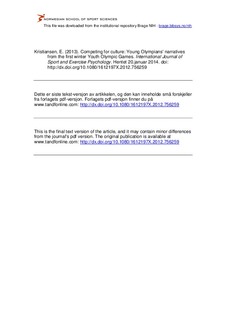| dc.contributor.author | Kristiansen, Elsa | |
| dc.date.accessioned | 2014-03-18T10:40:02Z | |
| dc.date.available | 2014-03-18T10:40:02Z | |
| dc.date.issued | 2013-01-11 | |
| dc.identifier.citation | International Journal of Sport and Exercise Psychology. 2013, under utgivelse. doi:10.1080/1612197X.2012.756259 | nb_NO |
| dc.identifier.uri | http://hdl.handle.net/11250/192530 | |
| dc.description | I Brage finner du siste tekst-versjon av artikkelen, og den kan inneholde ubetydelige forskjeller fra forlagets pdf-versjon. Forlagets pdf-versjon finner du på www.tandfonline.com: http://dx.doi.org/10.1080/1612197X.2012.756259 / In Brage you'll find the final text version of the article, and it may contain insignificant differences from the journal's pdf version. The definitive version is available at www.tandfonline.com: http://dx.doi.org/10.1080/1612197X.2012.756259 | nb_NO |
| dc.description.abstract | The purpose of this investigation was to study how the Norwegian Olympic Youth Team experienced the first winter Youth Olympic Games (YOG) by examining how they balanced the regular competitive programme, the Culture and Education Programme (CEP) in addition to several innovative events. Nine athletes were interviewed. Their experiences and perceptions of stressors differed according to the extent of their sports competitive programme during the 10 days of the Games. The results are presented in three narratives: the curler (with an extensive competitive programme), the biathlete (with a more balanced programme), and the luger (with one competition and sufficient time to take part in the CEP). As the curler took part both in a regular competitive event and an innovative one, YOG was all about competing and trying to get enough rest whenever possible. The biathlete with a balanced programme had time to experience all that YOG had to offer, while the luger would have benefitted from additional competition, regular or innovative. In order to cope, different types of social support from coaches, teammates and parents, together with cognitive strategies, were mentioned as important. The athletes' main goal for YOG is to take part in competition. However, if the International Olympic Committee wants all the athletes to embrace the cultural learning possibilities offered during the Games, future organizers should balance a cultural-competitive programme for all athletes. | nb_NO |
| dc.language.iso | eng | nb_NO |
| dc.publisher | Taylor & Francis | nb_NO |
| dc.subject | adolescent elite athletes | nb_NO |
| dc.subject | coping | nb_NO |
| dc.subject | competitive and organizational stress | nb_NO |
| dc.subject | Culture and Education Programme | nb_NO |
| dc.subject | VDP::Samfunnsvitenskap: 200::Samfunnsvitenskapelige idrettsfag: 330 | nb_NO |
| dc.title | Competing for culture: Young Olympians' narratives from the first winter Youth Olympic Games | nb_NO |
| dc.type | Journal article | nb_NO |
| dc.type | Peer reviewed | nb_NO |
| dc.source.journal | International Journal of Sport and Exercise Psychology | nb_NO |
| dc.identifier.doi | 10.1080/1612197X.2012.756259 | |
| dc.description.localcode | Seksjon for kultur og samfunn / Department of Cultural and Social Studies | nb_NO |
